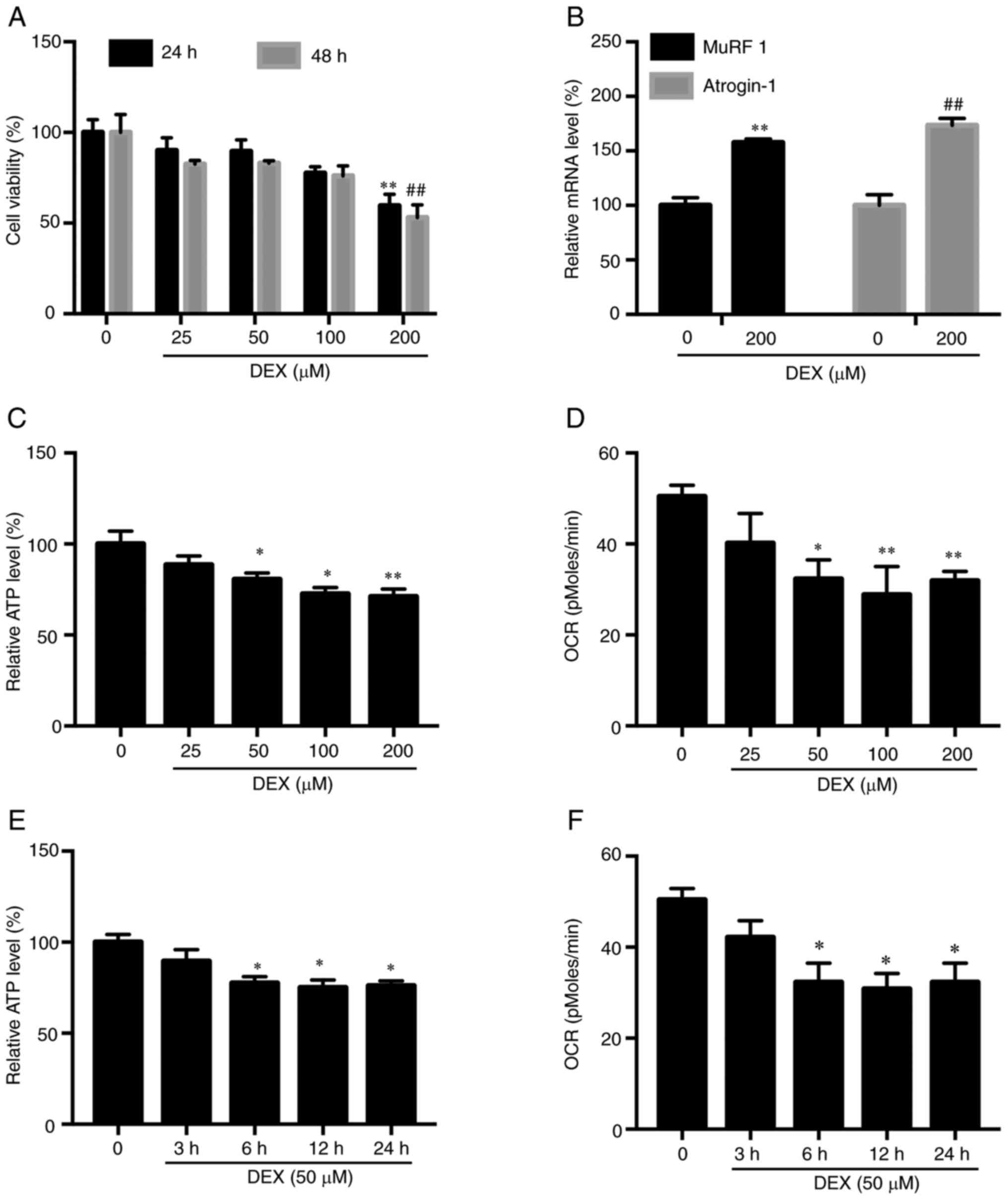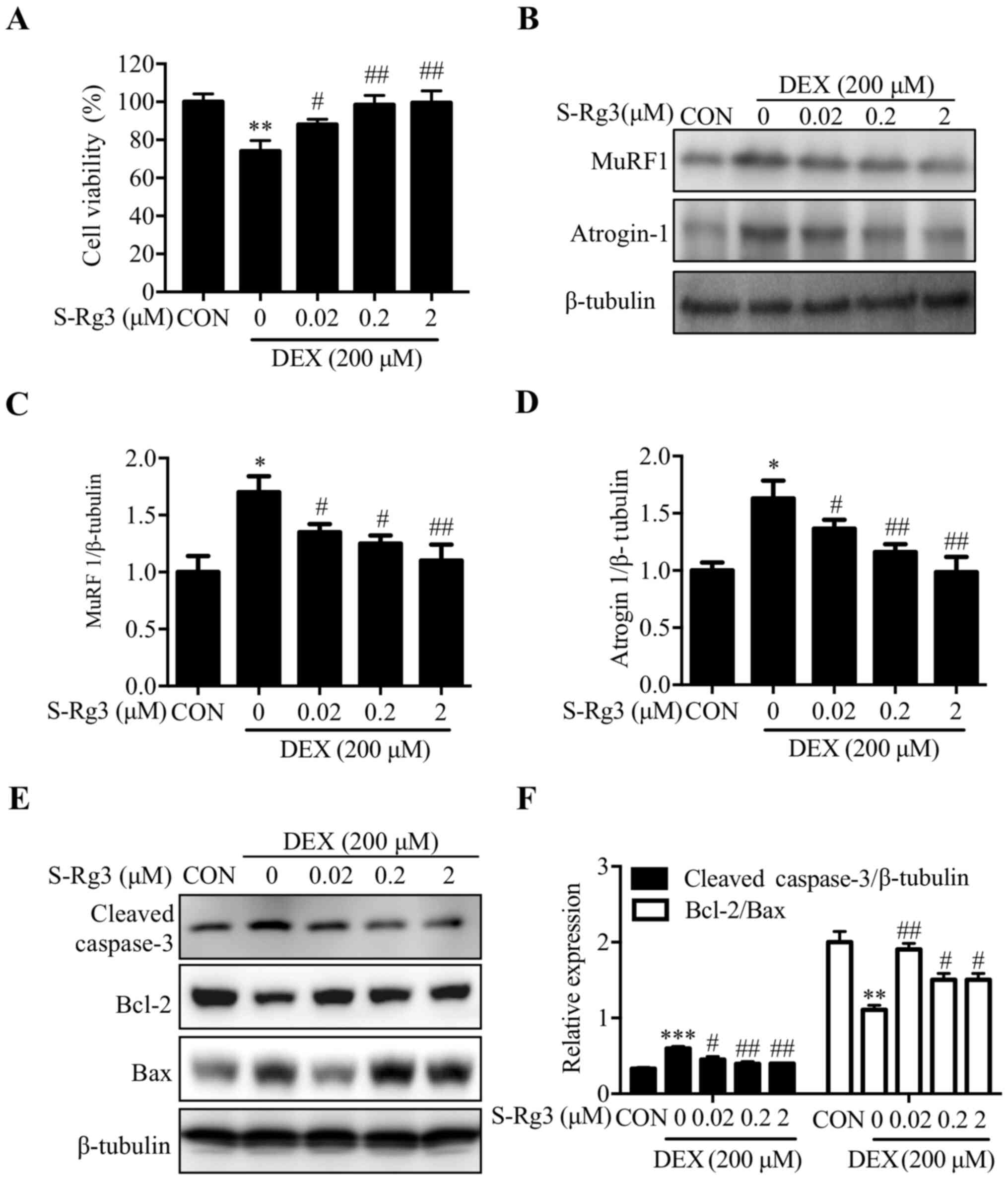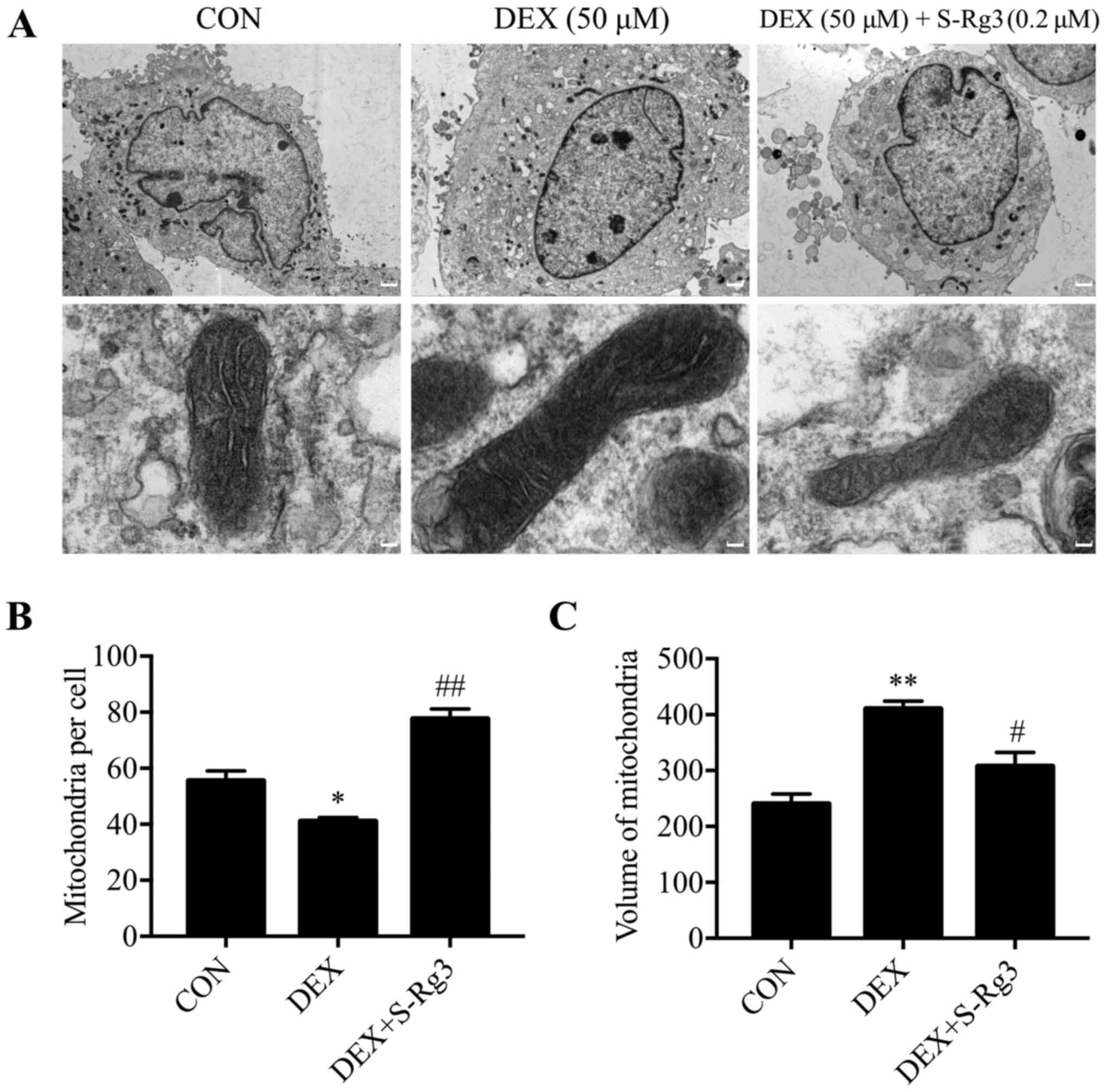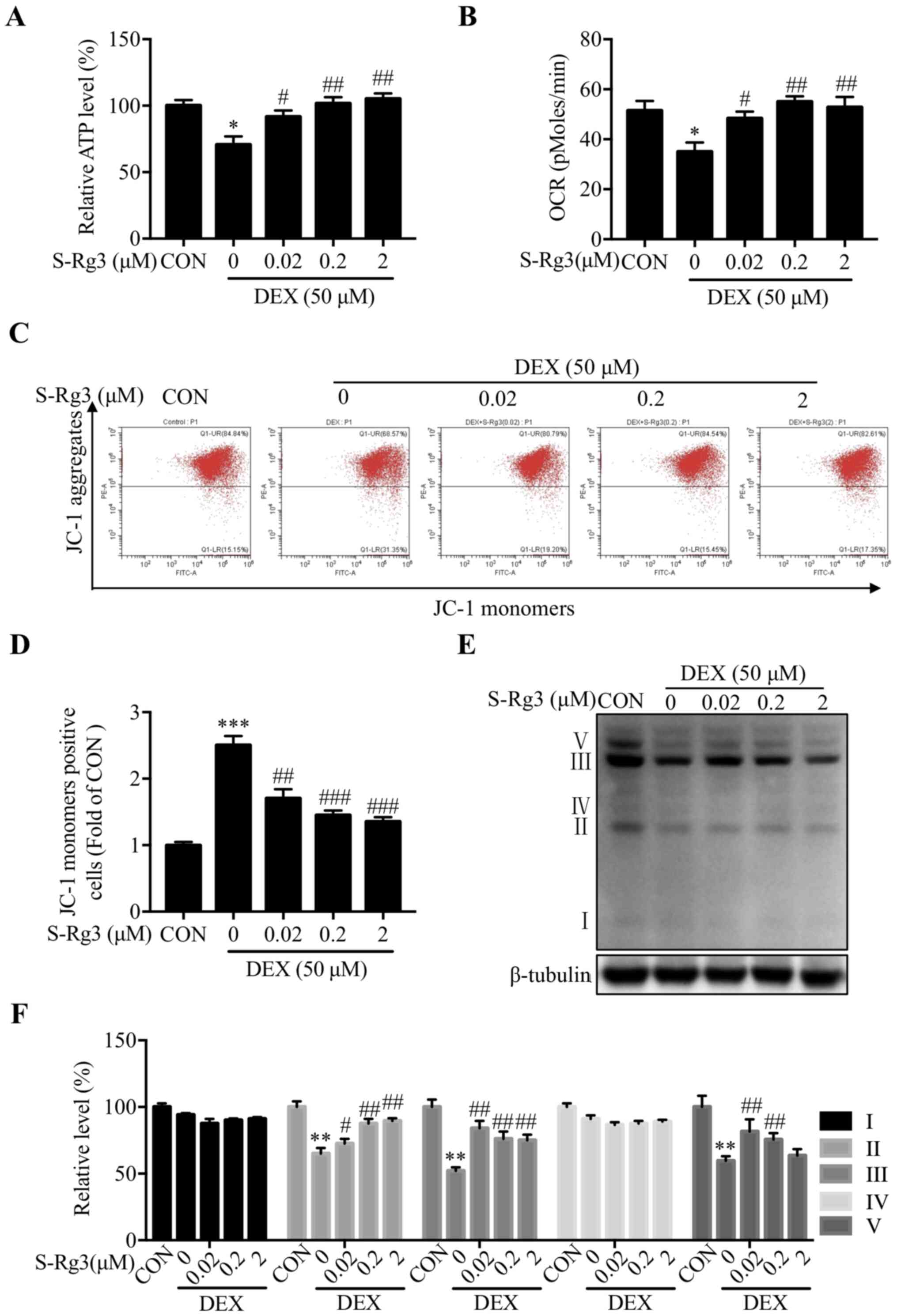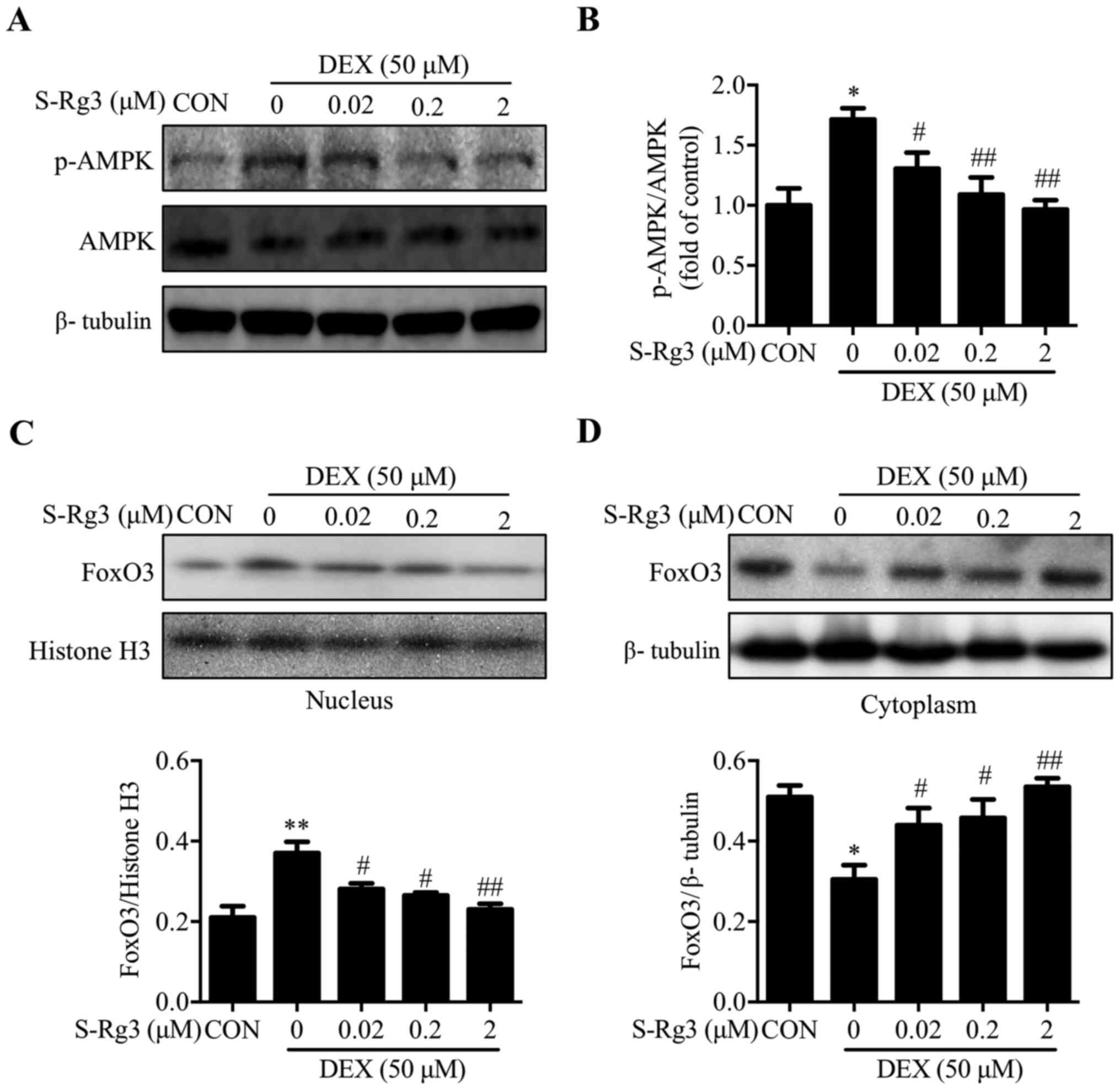|
1
|
Ottens TH, Nijsten MW, Hofland J, Dieleman
JM, Hoekstra M, van Dijk D and van der Maaten JM: Effect of
high-dose dexamethasone on perioperative lactate levels and glucose
control: A randomized controlled trial. Crit Care. 19:412015.
View Article : Google Scholar : PubMed/NCBI
|
|
2
|
Gong H, Liu L, Ni CX, Zhang Y, Su WJ, Lian
YJ, Peng W, Zhang JP and Jiang CL: Dexamethasone rapidly inhibits
glucose uptake via non-genomic mechanisms in contracting myotubes.
Arch Biochem Biophys. 603:102–109. 2016. View Article : Google Scholar : PubMed/NCBI
|
|
3
|
Pasieka AM and Rafacho A: Impact of
glucocorticoid excess on glucose tolerance: Clinical and
preclinical evidence. Metabolites. 6:242016. View Article : Google Scholar
|
|
4
|
Engel AG: Electron microscopic
observations in thyrotoxic and corticosteroid-induced myopathies.
Mayo Clin Proc. 41:785–796. 1966.PubMed/NCBI
|
|
5
|
Oshima Y, Kuroda Y, Kunishige M, Matsumoto
T and Mitsui T: Oxidative stress-associated mitochondrial
dysfunction in corticosteroid-treated muscle cells. Muscle Nerve.
30:49–54. 2004. View Article : Google Scholar : PubMed/NCBI
|
|
6
|
Pereira RM and Freire de Carvalho J:
Glucocorticoid-induced myopathy. Joint Bone Spine. 78:41–44. 2011.
View Article : Google Scholar : PubMed/NCBI
|
|
7
|
Qin W, Pan J, Wu Y, Bauman WA and Cardozo
C: Protection against dexamethasone-induced muscle atrophy is
related to modulation by testosterone of FOXO1 and PGC-1α. Biochem
Biophys Res Commun. 403:473–478. 2010. View Article : Google Scholar : PubMed/NCBI
|
|
8
|
Kuo T, Harris CA and Wang JC: Metabolic
functions of glucocorticoid receptor in skeletal muscle. Mol Cell
Endocrinol. 380:79–88. 2013. View Article : Google Scholar : PubMed/NCBI
|
|
9
|
Ochi A, Abe T, Nakao R, Yamamoto Y,
Kitahata K, Takagi M, Hirasaka K, Ohno A, Teshima-Kondo S, Taesik
G, et al: N-myristoylated ubiquitin ligase Cbl-b inhibitor prevents
on glucocorticoid-induced atrophy in mouse skeletal muscle. Arch
Biochem Biophys. 570:23–31. 2015. View Article : Google Scholar : PubMed/NCBI
|
|
10
|
Jackman RW and Kandarian SC: The molecular
basis of skeletal muscle atrophy. Am J Physiol Cell Physiol.
287:C834–C843. 2004. View Article : Google Scholar : PubMed/NCBI
|
|
11
|
Gonnella P, Alamdari N, Tizio S, Aversa Z,
Petkova V and Hasselgren PO: C/EBPβ regulates dexamethasone-induced
muscle cell atrophy and expression of atrogin-1 and MuRF1. J Cell
Biochem. 112:1737–1748. 2011. View Article : Google Scholar : PubMed/NCBI
|
|
12
|
Shen S, Liao Q, Liu J, Pan R, Lee SM and
Lin L: Myricanol rescues dexamethasone-induced muscle dysfunction
via a sirtuin 1-dependent mechanism. J Cachexia Sarcopenia Muscle.
10:429–444. 2019. View Article : Google Scholar : PubMed/NCBI
|
|
13
|
Weng J, Wang YH, Li M, Zhang DY and Jiang
BG: GSK3β inhibitor promotes myelination and mitigates muscle
atrophy after peripheral nerve injury. Neural Regen Res.
13:324–330. 2018. View Article : Google Scholar : PubMed/NCBI
|
|
14
|
Yoshioka Y, Kubota Y, Samukawa Y,
Yamashita Y and Ashida H: Glabridin inhibits dexamethasone-induced
muscle atrophy. Arch Biochem Biophys. 664:157–166. 2019. View Article : Google Scholar : PubMed/NCBI
|
|
15
|
Zhang SF, Zhang Y, Li B and Chen N:
Physical inactivity induces the atrophy of skeletal muscle of rats
through activating AMPK/FoxO3 signal pathway. Eur Rev Med Pharmacol
Sci. 22:199–209. 2018.PubMed/NCBI
|
|
16
|
Hu R, Wang MQ, Liu LY, You HY, Wu XH, Liu
YY, Wang YJ, Lu L, Xiao W and Wei LB: Calycosin inhibited autophagy
and oxidative stress in chronic kidney disease skeletal muscle
atrophy by regulating AMPK/SKP2/CARM1 signalling pathway. J Cell
Mol Med. 24:11084–11099. 2020. View Article : Google Scholar : PubMed/NCBI
|
|
17
|
Paggio A, Checchetto V, Campo A, Menabò R,
Di Marco G, Di Lisa F, Szabo I, Rizzuto R and De Stefani D:
Identification of an ATP-sensitive potassium channel in
mitochondria. Nature. 572:609–613. 2019. View Article : Google Scholar : PubMed/NCBI
|
|
18
|
Seok YM, Yoo JM, Nam Y, Kim J, Kim JS, Son
JH and Kim HJ: Mountain ginseng inhibits skeletal muscle atrophy by
decreasing muscle RING finger protein-1 and atrogin1 through
forkhead box O3 in L6 myotubes. J Ethnopharmacol. 270:1135572020.
View Article : Google Scholar : PubMed/NCBI
|
|
19
|
Lee MK, Choi JW, Choi YH and Nam TJ:
Pyropia yezoensis protein prevents dexamethasone-induced
myotube atrophy in C2C12 myotubes. Mar Drugs. 16:4972018.
View Article : Google Scholar
|
|
20
|
Ma YL, Sun YZ and Yang HH: Protective
effect of RenShen compound and DanHuang compound on muscle atrophy
in suspended rats. Space Med Med Eng (Beijing). 12:281–283.
1999.(In Chinese). PubMed/NCBI
|
|
21
|
Takamura Y, Nomura M, Uchiyama A and
Fujita S: Effects of aerobic exercise combined with panaxatriol
derived from ginseng on insulin resistance and skeletal muscle mass
in type 2 diabetic mice. J Nutr Sci Vitaminol (Tokyo). 63:339–348.
2017. View Article : Google Scholar : PubMed/NCBI
|
|
22
|
Li F, Li X, Peng X, Sun L, Jia S, Wang P,
Ma S, Zhao H, Yu Q and Huo H: Ginsenoside Rg1 prevents
starvation-induced muscle protein degradation via regulation of
AKT/mTOR/FoxO signaling in C2C12 myotubes. Exp Ther Med.
14:1241–1247. 2017. View Article : Google Scholar : PubMed/NCBI
|
|
23
|
Go GY, Lee SJ, Jo A, Lee J, Seo DW, Kang
JS, Kim SK, Kim SN, Kim YK and Bae GU: Ginsenoside Rg1 from Panax
ginseng enhances myoblast differentiation and myotube growth. J
Ginseng Res. 41:608–614. 2017. View Article : Google Scholar : PubMed/NCBI
|
|
24
|
Lee SJ, Bae JH, Lee H, Lee H, Park J, Kang
JS and Bae GU: Ginsenoside Rg3 upregulates myotube formation and
mitochondrial function, thereby protecting myotube atrophy induced
by tumor necrosis factor-alpha. J Ethnopharmacol. 242:1120542019.
View Article : Google Scholar : PubMed/NCBI
|
|
25
|
Wang M, Ren J, Chen X, Liu J, Xu X, Li X,
Zhao D and Sun L: 20(S)-ginsenoside Rg3 promotes myoblast
differentiation and protects against myotube atrophy via regulation
of the Akt/mTOR/FoxO3 pathway. Biochem Pharmacol. 180:1141452020.
View Article : Google Scholar : PubMed/NCBI
|
|
26
|
Rovetta F, Stacchiotti A, Faggi F,
Catalani S, Apostoli P, Fanzani A and Aleo MF: Cobalt triggers
necrotic cell death and atrophy in skeletal C2C12 myotubes. Toxicol
Appl Pharmacol. 271:196–205. 2013. View Article : Google Scholar : PubMed/NCBI
|
|
27
|
Wang M, Chen X, Jin W, Xu X, Li X and Sun
L: Ginsenoside Rb3 exerts protective properties against cigarette
smoke extract-induced cell injury by inhibiting the p38 MAPK/NF-κB
and TGF-β1/VEGF pathways in fibroblasts and epithelial cells.
Biomed Pharmacother. 108:1751–1758. 2018. View Article : Google Scholar : PubMed/NCBI
|
|
28
|
Meng F, Su X, Li W and Zheng Y:
Ginsenoside Rb3 strengthens the hypoglycemic effect through AMPK
for inhibition of hepatic gluconeogenesis. Exp Ther Med.
13:2551–2557. 2017. View Article : Google Scholar : PubMed/NCBI
|
|
29
|
Gwag T, Park K, Kim E, Son C, Park J,
Nikawa T and Choi I: Inhibition of C2C12 myotube atrophy by a novel
HSP70 inducer, celastrol, via activation of Akt1 and ERK1/2
pathways. Arch Biochem Biophys. 537:21–30. 2013. View Article : Google Scholar : PubMed/NCBI
|
|
30
|
Liu J, Peng Y, Wang X, Fan Y, Qin C, Shi
L, Tang Y, Cao K, Li H, Long J and Liu J: Mitochondrial dysfunction
launches dexamethasone-induced skeletal muscle atrophy via
AMPK/FOXO3 signaling. Mol Pharm. 13:73–84. 2016. View Article : Google Scholar : PubMed/NCBI
|
|
31
|
Will Y and Dykens J: Mitochondrial
toxicity assessment in industry-a decade of technology development
and insight. Expert Opin Drug Metab Toxicol. 10:1061–1067. 2014.
View Article : Google Scholar : PubMed/NCBI
|
|
32
|
Chen WC, Hsieh SR, Chiu CH, Hsu BD and
Liou YM: Molecular identification for
epigallocatechin-3-gallate-mediated antioxidant intervention on the
H2O2-induced oxidative stress in H9c2 rat cardiomyoblasts. J Biomed
Sci. 21:562014. View Article : Google Scholar : PubMed/NCBI
|
|
33
|
Livak KJ and Schmittgen TD: Analysis of
relative gene expression data using real-time quantitative PCR and
the 2(-Delta Delta C(T)) method. Methods. 25:402–408. 2001.
View Article : Google Scholar : PubMed/NCBI
|
|
34
|
Huang Q, Lou T, Wang M, Xue L, Lu J, Zhang
H, Zhang Z, Wang H, Jing C, Zhao D, et al: Compound K inhibits
autophagy-mediated apoptosis induced by oxygen and glucose
deprivation/reperfusion via regulating AMPK-mTOR pathway in
neurons. Life Sci. 254:1177932020. View Article : Google Scholar : PubMed/NCBI
|
|
35
|
Troncoso R, Paredes F, Parra V, Gatica D,
Vásquez-Trincado C, Quiroga C, Bravo-Sagua R, López-Crisosto C,
Rodriguez AE, Oyarzún AP, et al: Dexamethasone-induced autophagy
mediates muscle atrophy through mitochondrial clearance. Cell
Cycle. 13:2281–2295. 2014. View Article : Google Scholar : PubMed/NCBI
|
|
36
|
Huang Y, Chen K, Ren Q, Yi L, Zhu J, Zhang
Q and Mi M: Dihydromyricetin attenuates dexamethasone-induced
muscle atrophy by improving mitochondrial function via the PGC-1α
pathway. Cell Physiol Biochem. 49:758–779. 2018. View Article : Google Scholar : PubMed/NCBI
|
|
37
|
Hardie DG, Ross FA and Hawley SA: AMPK: A
nutrient and energy sensor that maintains energy homeostasis. Nat
Rev Mol Cell Biol. 13:251–262. 2012. View Article : Google Scholar : PubMed/NCBI
|
|
38
|
Zheng WL, Wang BJ, Wang L, Shan YP, Zou H,
Song RL, Wang T, Gu JH, Yuan Y, Liu XZ, et al: ROS-mediated cell
cycle arrest and apoptosis induced by zearalenone in mouse sertoli
cells via ER stress and the ATP/AMPK pathway. Toxins (Basel).
10:242018. View Article : Google Scholar
|
|
39
|
Sandri M, Sandri C, Gilbert A, Skurk C,
Calabria E, Picard A, Walsh K, Schiaffino S, Lecker SH and Goldberg
AL: Foxo transcription factors induce the atrophy-related ubiquitin
ligase atrogin-1 and cause skeletal muscle atrophy. Cell.
117:399–412. 2004. View Article : Google Scholar : PubMed/NCBI
|
|
40
|
DiMauro S, Garone C and Naini A: Metabolic
myopathies. Curr Rheumatol Rep. 12:386–393. 2010. View Article : Google Scholar : PubMed/NCBI
|
|
41
|
Kim JW, Ku SK, Han MH, Kim KY, Kim SG, Kim
GY, Hwang HJ, Kim BW, Kim CM and Choi YH: The administration of
Fructus Schisandrae attenuates dexamethasone-induced muscle
atrophy in mice. Int J Mol Med. 36:29–42. 2015. View Article : Google Scholar : PubMed/NCBI
|
|
42
|
Shimizu N, Yoshikawa N, Ito N, Maruyama T,
Suzuki Y, Takeda S, Nakae J, Tagata Y, Nishitani S, Takehana K, et
al: Crosstalk between glucocorticoid receptor and nutritional
sensor mTOR in skeletal muscle. Cell Metab. 13:170–182. 2011.
View Article : Google Scholar : PubMed/NCBI
|
|
43
|
Jiang R, Wang M, Shi L, Zhou J, Ma R, Feng
K, Chen X, Xu X, Li X, Li T and Sun L: Panax ginseng total protein
facilitates recovery from dexamethasone-induced muscle atrophy
through the activation of glucose consumption in C2C12 myotubes.
Biomed Res Int. 2019:37196432019. View Article : Google Scholar : PubMed/NCBI
|
|
44
|
Xu D, Jiang Z, Sun Z, Wang L, Zhao G,
Hassan HM, Fan S, Zhou W, Han S, Zhang L and Wang T: Mitochondrial
dysfunction and inhibition of myoblast differentiation in mice with
high-fat-diet-induced pre-diabetes. J Cell Physiol. 234:7510–7523.
2019. View Article : Google Scholar : PubMed/NCBI
|
|
45
|
Gosker HR, Engelen MP, van Mameren H, van
Dijk PJ, van der Vusse GJ, Wouters EF and Schols AM: Muscle fiber
type IIX atrophy is involved in the loss of fat-free mass in
chronic obstructive pulmonary disease. Am J Clin Nutr. 76:113–119.
2002. View Article : Google Scholar : PubMed/NCBI
|
|
46
|
Atherton PJ, Greenhaff PL, Phillips SM,
Bodine SC, Adams CM and Lang CH: Control of skeletal muscle atrophy
in response to disuse: Clinical/preclinical contentions and
fallacies of evidence. Am J Physiol Endocrinol Metab.
311:E594–E604. 2016. View Article : Google Scholar : PubMed/NCBI
|
|
47
|
Romanello V and Sandri M: Mitochondrial
biogenesis and fragmentation as regulators of protein degradation
in striated muscles. J Mol Cell Cardiol. 55:64–72. 2013. View Article : Google Scholar : PubMed/NCBI
|
|
48
|
Chen LE, Silver WP, Seaber AV, Korompilias
AV and Urbaniak JR: Effects of dexamethasone on the contractile
function of reperfused skeletal muscle. Microsurgery. 17:313–320.
1996. View Article : Google Scholar : PubMed/NCBI
|
|
49
|
Liu J, Peng Y, Feng Z, Shi W, Qu L, Li Y,
Liu J and Long J: Reloading functionally ameliorates disuse-induced
muscle atrophy by reversing mitochondrial dysfunction, and similar
benefits are gained by administering a combination of mitochondrial
nutrients. Free Radic Biol Med. 69:116–128. 2014. View Article : Google Scholar : PubMed/NCBI
|
|
50
|
Liu J, Deng K, Pan M, Liu G, Wu J, Yang M,
Huang D, Zhang W and Mai K: Dietary carbohydrates influence muscle
texture of olive flounder Paralichthys olivaceus through
impacting mitochondria function and metabolism of glycogen and
protein. Sci Rep. 10:218112020. View Article : Google Scholar : PubMed/NCBI
|
|
51
|
Jager S, Handschin C, St-Pierre J and
Spiegelman BM: AMP-activated protein kinase (AMPK) action in
skeletal muscle via direct phosphorylation of PGC-1alpha. Proc Natl
Acad Sci USA. 104:12017–12022. 2007. View Article : Google Scholar : PubMed/NCBI
|
|
52
|
Prieto I, Alarcón CR, García-Gómez R,
Berdún R, Urgel T, Portero M, Pamplona R, Martínez-Ruiz A,
Ruiz-Sanz JI, Ruiz-Larrea MB, et al: Metabolic adaptations in
spontaneously immortalized PGC-1α knock-out mouse embryonic
fibroblasts increase their oncogenic potential. Redox Biol.
29:1013962020. View Article : Google Scholar : PubMed/NCBI
|
|
53
|
Han DS, Yang WS and Kao TW: Dexamethasone
treatment at the myoblast stage enhanced C2C12 Myocyte
differentiation. Int J Med Sci. 14:434–443. 2017. View Article : Google Scholar : PubMed/NCBI
|
|
54
|
Romanello V, Guadagnin E, Gomes L, Roder
I, Sandri C, Petersen Y, Milan G, Masiero E, Del Piccolo P, Foretz
M, et al: Mitochondrial fission and remodelling contributes to
muscle atrophy. EMBO J. 29:1774–1785. 2010. View Article : Google Scholar : PubMed/NCBI
|















